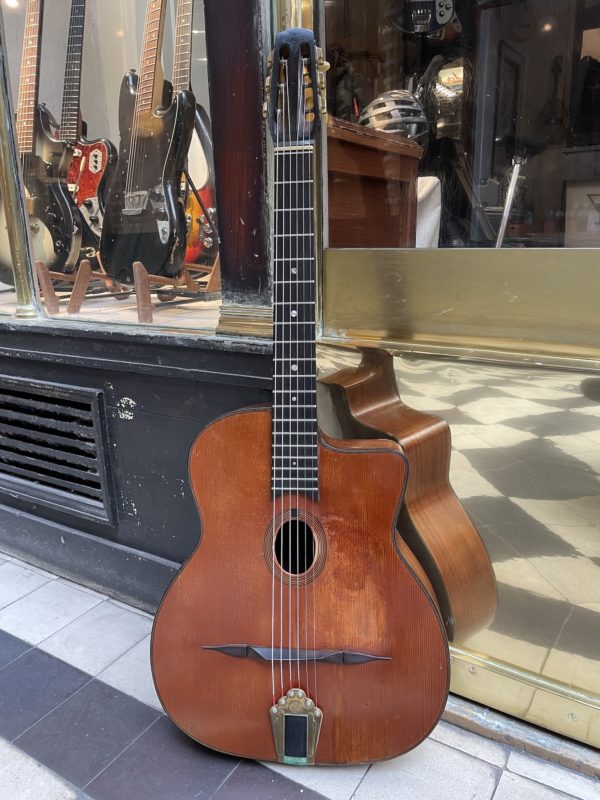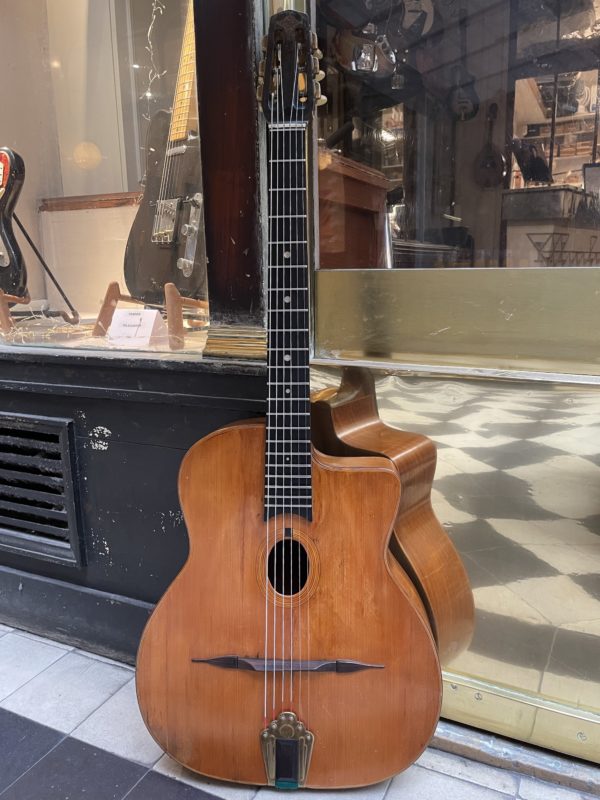Selmer
Selmer
SELMER
Selmer – Maccaferri guitars represent in the world and the history of the steel-string acoustic guitar what today would be called a cultural exception “à la française”, or more precisely “à la franco-italienne” in this case.
Indeed, Mario Maccaferri (1900-1993) was one of the many Italian and Sicilian luthiers who came to settle in France during the 1930s, who would influence and sustain French instrument production. However, Mario Maccaferri is an exception within this community in that before his arrival in France he was an award-winning violin and guitar luthier, a holder of numerous patents, a former student of the famous luthier and guitarist Luigi Mozzani (1869-1943) from whom he was greatly inspired, a qualified guitar teacher and a renowned international concert performer, whereas most of his compatriots were only small emigrant craftsmen who often fled the black shirts of fascism, and a misery of the same shade. Thus, alongside the French workshops of Mirecourt – Gérôme, Couesnon, Patenotte – and Paris with in particular that of Pierre Fontaine, the modest families Favino, Castelluccia, Di Mauro, Anastasio, Busato, Olivieri, Rossi, Burgassi, Picco, Bucolo, Pappalardo and Jacobacci will reign over the popular French instrumental manufacture from before the war until the beginning of the 1970s, producing as a whole, under their own name or those of their distributor, a quantity of instruments worthy of a large American company. Apart from their origin and condition, they all have one thing in common: they copied and adapted the model of steel-string guitar designed by Mario Maccaferri for Selmer. The latter, a specialist in woodwinds and brass since its creation in 1900, began its unexpected collaboration with the Italian luthier in 1931 by entrusting him with the creation of an entire line of guitars including, in addition to the gut instruments common of the time period, steel string guitars dedicated to Hawaiian and jazz music, which was then flourishing. If the talent and inventiveness of Maccaferri allowed him to open the field of production of the Selmer factories, his stubbornness and some contractual dissensions will get the better of this collaboration in 1934. This furtive yet intense adventure is not without evoking that of Lloyd Loar at Gibson. The guitar workshop would last a long time at Selmer until 1952, keeping only a refined version of steel-string guitar directly derived from the Maccaferri model. As for the luthier, having abandoned his concert career following an accident to his right hand, he immigrated to the United States right as the war was about to break out, where he created and marketed plastic reeds, violins, guitars and ukuleles until his death. Apart from the plastic guitars which were a failure, these multiple inventions will make his fortune and his success.
The first Selmer / Maccaferri model with steel strings, called the Orchestre, was inspired to Mario Maccaferri by the Neapolitan mandolin whose principle of construction of the top, slightly folded downwards behind its floating bridge, provides it with significant tension. The top of the Orchestre model is thus vaulted lengthwise but also widthwise, since it is glued to curved braces. The bracing consists of two main horizontal bars placed above and below the large oval “D” shaped rosette, and two more above and below the bridge. Two thin bars glued near the neck stiffen the top of the table and two other vertical ones are positioned under the feet of the bridge. For reasons of weight and solidity, the back – also supported by slightly curved braces – and the sides are, with a few rare exceptions, made of plywood combining mahogany, maple and rosewood. Long before American guitars, the body has a cutaway, an innovation inherited from Luigi Mozzani. The three-piece necks are predominantly walnut and feature twelve-fret necks. The wide and flat heel as well as the slotted trapeze-shaped head are attached to the central section reinforced by three or four thin strips of duralumin metal. The ebony fingerboard receives a zero fret and is extended above the rosette, thus offering 24 frets for the B and E strings. The tuners, revolutionary for the time, have a cover and are lubricated. The floating ebony bridge is compensated, and inserted between two mustaches acting as a reference mark. Also featured is a metal tailpiece to receive strings with ball or loop ends. Compared to American steel-string guitars of the same period, the dimensions are very reasonable: for a 64 cm scale, the thickness of the body is 8.9 cm at the neck, 11.1 cm at the waist, and 10.4 cm at the lower end; body length is 47cm; width at the shoulders of 29 cm, 25 cm at the waist, and 40 cm at the lower bout. Finally, the Orchestre model, like the Concert model with gut strings manufactured by Selmer – Maccaferri, has an internal resonator. It is a second body inside the first, designed to free the sound from the physical constraint of the instrumentalist on the external parts of the instrument. The resonator occupies the entire bottom portion of the guitar where it is fixed at three or four points; the back is reinforced with a crossbar and the walnut binding follows the contours of the main binding; a sound reflector glued to the bottom of the body is installed directly under the mouth, the oval shape of which is explained by the very presence of the resonator. What was to be an acoustic revolution ended in a simple revolt, that of the musicians who did not make much of this innovation. The expected result, namely a sound volume and an unrestrained and increased timbre, did not actually prove to be very convincing on the Orchestre model, the resonance of the top at the attack of the strings being frank and immediate.
After the departure of Mario Maccaferri, the house Selmer proposes a model with similar proportions and materials but with new characteristics: a small oval rosette in the shape of “0” replaces the large mouth in “D”; the narrower neck now offers fourteen frets out of boxes; an additional bar is added in the lower part of the guitar. Despite having a common appearance, the Selmer – Maccaferri and Selmer models sound very different. This is perfectly illustrated by listening to the musician thanks to whom these two atypical guitars became famous and have endured: Django Reinhardt, the unique.
In the collective and global imagination of the contemporary guitarist, Selmer-type guitars, which are also called “gypsy” more for ease than for real musical reasons, are therefore carnally linked to the volubility of jazz musician Django Reinhardt, to the eloquence of the entire Ferré family with Baro, Sarane, Matelo, Boulou & Elios and to the talent in general of all men of the art more or less less known from the heroic period of the balluches of the Bastille, the cellars of St Germain-des-Prés, the Puces de Clignancourt. Thus, if they were and remain the touchstone of the jazz-swing called “manouche”, they are no less consubstantial with the musette genre, the typical & exotic styles, the French chanson as well as the Corsican waltz, and even the malouf of North Africa.
As early as 1932, the appearance of the Selmer guitar, an expensive instrument intended for professionals, led to the creation of an almost innumerable quantity of imitations and interpretations of the Selmer concept, the most beautiful and faithful productions of which still today come from the workshops of Bortolo Busato and Jacques Favino. With these three graces, we can even speak of a “troika of dancers” when we talk about this podium. Since then, the Selmer type guitar has proven to be an unprecedented phenomenon in the history of French instrument making. It embodies both the popular French music of its time and, par excellence, the most original and long-lasting steel-string guitar ever created in Europe, the aura of which today has largely overflowed borders.



